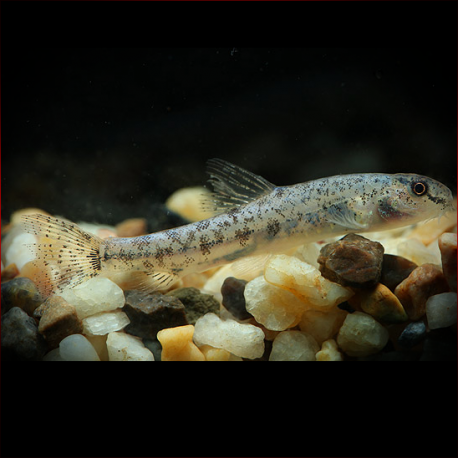More info
Datasheet
| Minimum Tank Size | 40 litres / 10.57 US gallons |
| Maximum Size | 2.6cm / 1.02inches |
| Temperature | 20°C / 68.00°F - 26°C / 78.80°F |
| Hardness | 2.02dgH / 36ppm - 12.05dgH / 215ppm |
| pH | 6.0-7.5 |
Behaviour:
Lepidocephalichthys spp. exhibit peaceful behavior with their tankmates, including other fishes, with no reports of them causing harm, although they may consume eggs or fry. They thrive in the company of conspecifics and are best kept in groups of four or more individuals. For instance, L. irrorata tends to do well when housed alongside fish species from similar environments that occupy the upper part of the water column such as Trichopodus, Trichogaster, Trichopsis, or certain Danio species. The presence of these upper-dwelling fish can help reduce timidity in L. irrorata, as in nature, the absence of fish in the upper water column often signals the approach of danger. Sand-dwelling loaches from the families Botiidae, Cobitidae, and Nemacheilidae can also be suitable tankmates, although proper research is essential as some species within these families can be territorial or aggressive.
Feeding and Diet:
Lepidocephalichthys spp. are likely micropredators that sift mouthfuls of substrate through their gills to extract food such as insect larvae and small crustaceans. In an aquarium setting, these loaches will usually accept sinking dried foods but should also be provided with regular meals of small live and frozen foods like Daphnia, Artemia, and bloodworms.
Reproduction & Dimorphism:
Information on the reproduction of Lepidocephalichthys spp. is unrecorded. In terms of sexual dimorphism, mature males of the species display enlarged pectoral fins with a unique structure called the lamina circularis, which is absent in females. Males also tend to have larger pectoral and pelvic fins and are notably smaller in size compared to females. Additionally, there are differences in color patterns, with adult females often having spots on their flanks while males exhibit a narrow, dark lateral stripe.
Habitat and Distribution:
Found predominantly in the middle and lower Mekong river system in Thailand and Vietnam, as well as the Chao Phraya drainage in central Thailand, Lepidocephalichthys spp. typically inhabit shallow, slow-moving sections of streams or calm habitats like swamps, oxbows, backwaters, and paddy fields. These habitats are often characterized by heavy vegetation or submerged roots and soft mud or silt substrates. The species adapts to varying water conditions across different seasons, including temporary flooding and stagnant periods with low oxygen levels.
Aquarium Setup:
To provide an optimal environment for Lepidocephalichthys spp., ensure the tank is equipped with a soft, sandy substrate to accommodate their burrowing behavior. Decorate the tank with water-worn rocks, driftwood branches, and tree roots to create hiding places and shaded spots, adding them before the substrate to prevent displacement by digging. Dim lighting is suitable unless you plan to grow plants, in which case, supplemental lighting may be necessary. Given their preference for sluggish waters, avoid high flow rates in the tank, although maintaining adequate oxygen levels is essential. To prevent escapes, ensure the tank is well-covered as these loaches may jump, particularly when first introduced.

